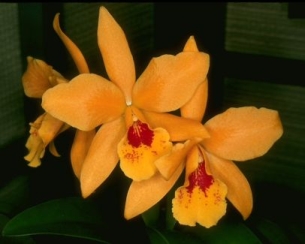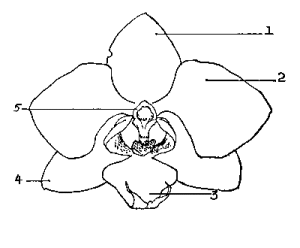Orchids form one of the largest and most diversified families of plants. The flowers are highly adapted for attracting, deceiving, and manipulating insects to achieve pollination. They seem to also be very successful in attracting humans to assist in their propagation.
Years ago plants and animals were classified and organized into a structure that showed the relationships of one organism to another. A set of rules defines how everything is to be named. Latin was the universal language of science at the time and is still used today in the naming conventions. The class of flowering plants or Angiospermae are divided into two subclasses, the Monocotyledonae (monocots) and the Dicotyledonae (dicots). Within the monocots is the super order Liliiflorae, which in turn contains the family of orchids, Orchidaceae.
Orchids are distinct from other flowering plants because:
- the stamens and style (male and female parts) are fused together in one structure known as a column
- there are three petals and three petal-like sepals
- usually has one different petal that forms a lip or labellum
making the flower bilaterally symmetrical - the pollen is usually bound together in a few large masses
known as pollinia - the flower stem twists around during development so that the lip is down (resupination).
- the seeds are tiny and numerous
- upon germination the embryo forms a tubercle (protocorm)
- under natural conditions most orchids will germinate only when a symbiosis
with a fungus has been established.

Orchids grow from the Arctic to the Equator and south in all the continents except Antarctica. The family of Orchids contains more species than any other family of plants. Botanists believe the family to contain some 20,000 to 25,000 species. With the destruction of the rainforests we are losing undiscovered species and may never
know the exact number.
The orchids that orchid growers are mostly interested in are the tropical epiphytes. Epiphytes are plants that grow upon other plants, usually in forests. By doing this they gain a better position to obtain more light. Their roots cling to branches of trees and obtain water only in rain or fog. Many orchids, bromeliads, ferns, mosses and lichens are epiphytes.
The Phalaenopsis Orchid
Key to the drawing:
1 – dorsal sepal
2 – petal
3 – lip
4 – lateral sepals
5 – column
Monocotyledons
Monocots, the Monocotyledonae include palms, duckweed, bamboo, grass, onions, bananas and the members of Liliiflorae. Some of their characteristics are:
- one cotyledon (embryonic seed leaf)
- the leaves are mostly parallel-veined.
- usually lacks cambium in the stem
- vascular bundles are usually scattered in the stem – no rings as in a tree
- flower parts usually in multiples of three
Dicotyledons
Dicots, the Dicotyledonae include peas, trees, roses, asters, mints and many other familiar flowering plants. Some of their characteristics are:
- two cotyledons (embryonic seed leaf)
- the leaves are mostly net-veined.
- cambium usually present in the stem
- vascular bundles are in rings as in a tree
- flower parts usually in multiples of five, seldom threes
Liliiflorae
Liliiflorae contains not only orchids but lilies, amaryllises and irises. All these plants develop their seeds in ovaries below the flower.

